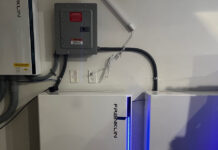
This is part two of an article recapping the installation of our whole-house solar system. Be sure to read about the first two days so you can get caught up.
Day Three
The roof crew is no longer needed, so our crew of six people is down to three. They complete the conduit running from the attic down to the inverter. Then they run the four wires down it and hook up the two strings of panels. One string is 10 panels, the other is 11.
They also tackle some of the heavy labor, like unpacking and setting up the batteries. They put in conduit to bring cable from the batteries to the combiner box and then to what I call the smart switch. Franklin, the manufacturer, calls it the aGate and the call the batteries aPower. Whatever. In any case, the aGate is a large box (see image) where power from the grid, the inverter, the batteries, and the generator all come together. The aGate is programmable and based on our settings determines where to send the solar power, whether to charge the batteries, or if it should send excess power back to the grid. It also senses when the grid goes down and switches the house over to battery power in less than 20 milliseconds.
Day Four
Three guys show up on day four, but one is new. Another is the licensed electrician who was here the first day. The other two report to him.
The morning goes quickly as they install a breaker box for the generator switch and the generator plug. That means we can now plug our generator in and recharge the batteries if we are in an outage during an intense snow store or a series of cloudy/rainy days in which little or no solar power is generated to replenish the batteries. Instead of using a network of extension cords from the generator to run our refrigerator, freezer, Wi-Fi, and a few other items, the generator will charge the batteries, which can run most of the house.
They also ran wires down the conduit they installed the day before, connecting the batteries to the rest of the system. When I opened the combiner box after Day 3, it had circuit breakers, but no wires. Now it and many other components are wired up.
Then they worked on the conduit and heavy cable that will run from the meter to the aGate and from the smart switch to the 200-amp service panel.
The Final Connection
When everything was done, they warned us they were pulling the meter for the final setup. We turned off our computers and the air conditioning and they shut off power. Since I couldn’t do much in the house, I used this power outage as a chance to mow the lawn.
When I was done mowing, they had made very little progress because they ran into an unexpected problem. When the home was built, whoever installed the cable from the meter to the circuit breakers cross-threaded the Allen-head bolt that held the cable to the 200-amp breaker at the top of the box. The guys could not remove it. I even gave them a pipe to apply additional pressure, and all we did was strip the inside of the Allen head. This brought the project to a screeching halt.
While they could remove the breaker from the panel, they didn’t have a replacement. After calling our local (i.e., within a 45 minute drive) hardware stores, we determined that no one else had a replacement for that particular brand either.
So they cleaned up, packed up, and headed home a few hours early. They won’t be back until Monday because much of the crew is taking Friday off for a long Independence Day weekend.
Next Step
Our system is about 90 percent installed. Once they finish the main connection, it still has to be commissioned, which includes programming the switch and testing everything. Once they get that done and everything works, it has to be inspected by the county. Then the utility has the option to inspect it. Eventually, the utility will give us permission to operate (PTO). That’s when we get to throw the big switch and the solar will kick in, powering the house for the first time.
My personal deadline has always been Independence Day, and we’re missing it. I am now hoping we will be inspected, approved and operating by July 26, which should give the inspectors plenty of time. To give them credit, our electric utility has been pretty good throughout this process. Every time we’ve filed paperwork, they have responded well before the deadline.
My next post on the solar install will be in a week.
Happy Independence Day!






